Adsorption Behavior and Kinetics of 1,4-Dioxane by Carbon Aerogel
Abstract
:1. Introduction
| Adsorbent | Initial Solute Concentration | Dosage | Qmax (mg-1,4-D g-Adsorbent−1) | Cycles (Recovery Rate) | Equilibrium Time | Reference |
|---|---|---|---|---|---|---|
| Norit 1240 GAC | 100 mg/L | 1 g | ~38 | _ | 72 h | [19] |
| Ambersorb 560 | 80 mg/L | _ | ~40 | _ | _ | [32] |
| Titanium Silicate-1 | 298 K, 500 mg/L | 100 mg | 85.17 | 3 (~100%) | 2 min | [33] |
| Sawdust GAC | 296 K | _ | 0.41 | _ | 16–24 h | [18] |
| ZSM-5 zeolite | 303 K, 100 mg/L | _ | 22.44 to 107.36 | _ | 1–8 h | [34] |
| CA125-800-1-2° | 308 K, 20 mg/L | 20 mg | 67.28 | 5 (~100%) | 1 h | [This work] |
2. Materials and Methods
2.1. Chemicals and Materials
2.2. CAs Preparation
2.3. Characterization
2.4. Adsorption Experiments
2.5. Analytical Methods
2.6. Regeneration Experiment
3. Results
3.1. The Investigation of Adsorption Properties
3.2. The Effect of CAs’ Porous Structure
3.3. 1,4-D Adsorption at Different pH
3.4. Adsorption Kinetics and Isotherm
3.5. Competitive Adsorption of 1,4-D and Trichloroethylene
3.6. Regeneration of CAs
3.7. The Impact of the Adsorbent Quantity
3.8. The Investigation of the Mechanism
- (1)
- Pore filling: according to the conclusions drawn from BET analysis (Table 3), the adsorption rates of 1,4-D by the three adsorbents (Figure 2) and the nitrogen absorption and desorption curve (Figure 4), it can be concluded that the adsorption form of CAs on the refractory organic pollutants is mainly physical adsorption, and the adsorption method is mainly pore filling, and the specific surface area and pore volume of carbon materials are larger. This enables a greater the adsorption capacity of 1,4-D.
- (2)
- Van der Waals force action: according to the adsorption dynamic equilibrium curve of 1,4-D, it can be seen that the adsorption of 1,4-D by CAs is mainly physical adsorption. Since the main force in the physical adsorption process is the van der Waals force, it can be inferred that the adsorption of 1,4-D by CAs has van der Waals forces.
- (3)
- Electrostatic attraction mechanism: the surface of CAs is usually negatively charged, which makes it easier for CAs to electrostatically adsorb positively charged organic compounds to form a stable adsorption interface. From a microscopic point of view, since 1,4-D is a polar solution, and polar molecules hydrogen and oxygen have different abilities to capture electrons, the shared electron pairs of the two will favor oxygen, resulting in a positive charge of oxygen, a negative charge of hydrogen, and a prominent oxygen atom. Therefore, 1,4-D will be absorbed to the surface of CAs due to the electrostatic attraction of the oxygen atom.
- (4)
- Electron donor/acceptor effect: according to infrared spectrum analysis, CAs contain a benzene ring as an electron acceptor and the -O- in the ether bond of 1,4-D as an electron donor. The two can enhance the adsorption capacity between the adsorbent and adsorbent through the electron donor/acceptor complex effect.
4. Conclusions
Author Contributions
Funding
Institutional Review Board Statement
Informed Consent Statement
Data Availability Statement
Conflicts of Interest
References
- Adamson, D.T.; de Blanc, P.C.; Farhat, S.K.; Newell, C.J. Implications of matrix diffusion on 1,4-dioxane persistence at contaminated groundwater sites. Sci. Total Environ. 2016, 562, 98–107. [Google Scholar] [CrossRef]
- Khan, N.A.; Johnson, M.D.; Carroll, K.C. Spectroscopic methods for aqueous cyclodextrin inclusion complex binding measurement for 1,4-dioxane, chlorinated co-contaminants, and ozone. J. Contam. Hydrol. 2018, 210, 31–41. [Google Scholar] [CrossRef]
- Adamson, D.T.; Pina, E.A.; Cartwright, A.E.; Rauch, S.R.; Hunter Anderson, R.; Mohr, T.; Connor, J.A. 1,4-Dioxane drinking water occurrence data from the third unregulated contaminant monitoring rule. Sci. Total Environ. 2017, 596–597, 236–245. [Google Scholar] [CrossRef]
- Miao, Y.; Johnson, N.W.; Phan, T.; Heck, K.; Gedalanga, P.B.; Zheng, X.; Adamson, D.; Newell, C.; Wong, M.S.; Mahendra, S. Monitoring, assessment, and prediction of microbial shifts in coupled catalysis and biodegradation of 1,4-dioxane and co-contaminants. Water Res. 2020, 173, 115540. [Google Scholar] [CrossRef] [PubMed]
- Xu, X.; Liu, S.; Smith, K.; Wang, Y.; Hu, H. Light-driven breakdown of 1,4-Dioxane for potable reuse: A review. Chem. Eng. J. 2019, 373, 508–518. [Google Scholar] [CrossRef]
- Tang, Y.; Mao, X. Recent Advances in 1,4-Dioxane Removal Technologies for Water and Wastewater Treatment. Water 2023, 15, 1535. [Google Scholar] [CrossRef]
- Bagheri, M.; Mohseni, M. Pilot-scale treatment of 1,4-dioxane contaminated waters using 185 nm radiation: Experimental and CFD modeling. J. Water Process Eng. 2017, 19, 185–192. [Google Scholar] [CrossRef]
- Zhang, S.; Gedalanga, P.B.; Mahendra, S. Advances in bioremediation of 1,4-dioxane-contaminated waters. J. Environ. Manag. 2017, 204 Pt 2, 765–774. [Google Scholar] [CrossRef]
- Yang, I.; Kwon, D.; Kim, M.-S.; Jung, J.C. A comparative study of activated carbon aerogel and commercial activated carbons as electrode materials for organic electric double-layer capacitors. Carbon 2018, 132, 503–511. [Google Scholar] [CrossRef]
- Preethi; Shanmugavel, S.P.; Kumar, G.; Yogalakshmi, K.N.; Gunasekaran, M.; Rajesh, B.J. Recent progress in mineralization of emerging contaminants by advanced oxidation process: A review. Environ. Pollut. 2024, 341, 122842. [Google Scholar] [CrossRef] [PubMed]
- Barndõk, H.; Blanco, L.; Hermosilla, D.; Blanco, Á. Heterogeneous photo-Fenton processes using zero valent iron microspheres for the treatment of wastewaters contaminated with 1,4-dioxane. Chem. Eng. J. 2016, 284, 112–121. [Google Scholar] [CrossRef]
- Barndõk, H.; Merayo, N.; Blanco, L.; Hermosilla, D.; Blanco, Á. Application of on-line FTIR methodology to study the mechanisms of heterogeneous advanced oxidation processes. Appl. Catal. B Environ. 2016, 185, 344–352. [Google Scholar] [CrossRef]
- Ersan, G.; Kaya, Y.; Apul, O.G.; Karanfil, T. Adsorption of organic contaminants by graphene nanosheets, carbon nanotubes and granular activated carbons under natural organic matter preloading conditions. Sci. Total Environ. 2016, 565, 811–817. [Google Scholar] [CrossRef]
- Eder, S.; Müller, K.; Azzari, P.; Arcifa, A.; Peydayesh, M.; Nyström, L. Mass Transfer Mechanism and Equilibrium Modelling of Hydroxytyrosol Adsorption on Olive Pit–Derived Activated Carbon. Chem. Eng. J. 2021, 404, 126519. [Google Scholar] [CrossRef]
- Świderska-Dąbrowska, R.; Piaskowski, K.; Zarzycki, P.K. Preliminary Studies of Synthetic Dye Adsorption on Iron Sludge and Activated Carbons. J. AOAC Int. 2018, 101, 1429–1436. [Google Scholar] [CrossRef]
- Hadi, P.; To, M.H.; Hui, C.W.; Lin, C.S.; McKay, G. Aqueous mercury adsorption by activated carbons. Water Res. 2015, 73, 37–55. [Google Scholar] [CrossRef] [PubMed]
- Cataldo, S.; Iannì, A.; Loddo, V.; Mirenda, E.; Palmisano, L.; Parrino, F.; Piazzese, D. Combination of advanced oxidation processes and active carbons adsorption for the treatment of simulated saline wastewater. Sep. Purif. Technol. 2016, 171, 101–111. [Google Scholar] [CrossRef]
- Fukuhara, T.; Iwasaki, S.; Hasegawa, T.; Ishihara, K.; Fujiwara, M.; Abe, I. Adsorption of 1,4-Dioxane from Aqueous Solutions onto Various Activated Carbons. J. Water Environ. Technol. 2011, 9, 249–258. [Google Scholar] [CrossRef]
- Myers, M.A.; Johnson, N.W.; Marin, E.Z.; Pornwongthong, P.; Liu, Y.; Gedalanga, P.B.; Mahendra, S. Abiotic and bioaugmented granular activated carbon for the treatment of 1,4-dioxane-contaminated water. Environ. Pollut. 2018, 240, 916–924. [Google Scholar] [CrossRef] [PubMed]
- Woodard, S.; Mohr, T.; Nickelsen, M.G. Ambersorb 560 Synthetic Media: A Promising New Treatment Technology for 1,4-Dioxane. Remediat. J. 2014, 24, 27–40. [Google Scholar] [CrossRef]
- Pekala, R.W.; Farmer, J.C.; Alviso, C.T.; Tran, T.D.; Mayer, S.T.; Miller, J.M.; Dunn, B. Carbon aerogels for electrochemical applications. J. Non-Cryst. Solids 1998, 225, 74–80. [Google Scholar] [CrossRef]
- Zhu, X.; Hope-Weeks, L.J.; Yu, Y.; Yuan, J.; Zhang, X.; Yu, H.; Liu, J.; Li, X.; Zeng, X. Effect of concentration of glycidol on the properties of resorcinol-formaldehyde aerogels and carbon aerogels. RSC Adv. 2022, 12, 20191–20198. [Google Scholar] [CrossRef] [PubMed]
- Yu, Z.L.; Li, G.C.; Fechler, N.; Yang, N.; Ma, Z.Y.; Wang, X.; Antonietti, M.; Yu, S.H. Polymerization under Hypersaline Conditions: A Robust Route to Phenolic Polymer-Derived Carbon Aerogels. Angew. Chem. 2016, 55, 14623–14627. [Google Scholar] [CrossRef]
- Molina-Campos, D.F.; Delgadillo, D.P.V.; Giraldo, L.; Moreno-Pirajan, J.C. Removal of metal ions Cd(II), Cr(VI) and Ni(II) from aqueous solution using an organic aerogel and carbon aerogel obtained by acid catalysis. Mater. Express 2020, 10, 127–139. [Google Scholar] [CrossRef]
- Li, Y.C.; Zhou, M.Q.; Waterhouse, G.I.N.; Sun, J.C.; Shi, W.J.; Ai, S.Y. Efficient removal of cadmium ions from water by adsorption on a magnetic carbon aerogel. Environ. Sci. Pollut. R. 2021, 28, 5149–5157. [Google Scholar] [CrossRef]
- Song, Z.; Chen, X.; Gong, X.; Gao, X.; Dai, Q.; Nguyen, T.T.; Guo, M. Luminescent carbon quantum dots/nanofibrillated cellulose composite aerogel for monitoring adsorption of heavy metal ions in water. Opt. Mater. 2020, 100, 109642. [Google Scholar] [CrossRef]
- Gan, G.; Li, X.; Fan, S.; Wang, L.; Qin, M.; Yin, Z.; Chen, G. Carbon Aerogels for Environmental Clean-Up. Eur. J. Inorg. Chem. 2019, 2019, 3126–3141. [Google Scholar] [CrossRef]
- Cotet, L.C.; Maicaneanu, A.; Fort, C.I.; Danciu, V. Alpha-Cypermethrin Pesticide Adsorption on Carbon Aerogel and Xerogel. Sep. Sci. Technol. 2013, 48, 2649–2658. [Google Scholar] [CrossRef]
- Achari, V.S.; Lopez, R.M.; Rajalekshmi, A.S.; Jayasree, S.; Ravindran, B.; Sekkar, V. Scavanging nitrophenol from aquatic effluents with triethyl amine catalyzed ambient pressure dried carbon aerogel. J. Environ. Chem. Eng. 2020, 8, 103670. [Google Scholar] [CrossRef]
- Kalotra, S.; Mehta, R. Carbon aerogel and polyaniline/carbon aerogel adsorbents for Acid Green 25 dye: Synthesis, characterization and an adsorption study. Chem. Eng. Commun. 2022, 209, 757–773. [Google Scholar] [CrossRef]
- Geca, M.; Wisniewska, M.; Nowicki, P. Biochars and activated carbons as adsorbents of inorganic and organic compounds from multicomponent systems—A review. Adv. Colloid. Interface Sci. 2022, 305, 102687. [Google Scholar] [CrossRef] [PubMed]
- DiGuiseppi, W.; Walecka-Hutchison, C.; Hatton, J. 1,4-Dioxane Treatment Technologies. Remediat. J. 2016, 27, 71–92. [Google Scholar] [CrossRef]
- Chen, R.; Liu, C.; Johnson, N.W.; Zhang, L.; Mahendra, S.; Liu, Y.; Dong, Y.; Chen, M. Removal of 1,4-dioxane by titanium silicalite-1: Separation mechanisms and bioregeneration of sorption sites. Chem. Eng. J. 2019, 371, 193–202. [Google Scholar] [CrossRef]
- Liu, Y.; Johnson, N.W.; Liu, C.; Chen, R.; Zhong, M.; Dong, Y.; Mahendra, S. Mechanisms of 1,4-Dioxane Biodegradation and Adsorption by Bio-Zeolite in the Presence of Chlorinated Solvents: Experimental and Molecular Dynamics Simulation Studies. Environ. Sci. Technol. 2019, 53, 14538–14547. [Google Scholar] [CrossRef] [PubMed]
- Yang, X.; Yang, D.; Zhang, G.; Zuo, H. Preparation of mesoporous carbon aerogels via ambient pressure drying using a self-sacrificing melamine-formaldehyde template. J. Power Sources 2021, 482, 229135. [Google Scholar] [CrossRef]
- Wei, H.L.; Han, L.L.; Tang, Y.C.; Ren, J.; Zhao, Z.B.; Jia, L.Y. Highly flexible heparin-modified chitosan/graphene oxide hybrid hydrogel as a super bilirubin adsorbent with excellent hemocompatibility. J. Mater. Chem. B 2015, 3, 1646–1654. [Google Scholar] [CrossRef] [PubMed]
- Chen, H.; Wang, S.; Tang, Y.; Zeng, F.; Schobert, H.H.; Zhang, X. Aromatic cluster and graphite-like structure distinguished by HRTEM in thermally altered coal and their genesis. Fuel 2021, 292, 120373. [Google Scholar] [CrossRef]
- Borowski, P.; Gac, W.; Pulay, P.; Woliński, K. The vibrational spectrum of 1,4-dioxane in aqueous solution–theory and experiment. New J. Chem. 2016, 40, 7663–7670. [Google Scholar] [CrossRef]
- Huang, J.Y.; Liang, Y.R.; Dong, H.W.; Hu, H.; Yu, P.F.; Peng, L.; Zheng, M.T.; Xiao, Y.; Liu, Y.L. Revealing contribution of pore size to high hydrogen storage capacity. Int. J. Hydrogen Energy 2018, 43, 18077–18082. [Google Scholar] [CrossRef]
- Grzyb, B.; Hildenbrand, C.; Berthon-Fabry, S.; Bégin, D.; Job, N.; Rigacci, A.; Achard, P. Functionalisation and chemical characterisation of cellulose-derived carbon aerogels. Carbon 2010, 48, 2297–2307. [Google Scholar] [CrossRef]
- Zhao, X.; Wang, X.; Lou, T. Simultaneous adsorption for cationic and anionic dyes using chitosan/electrospun sodium alginate nanofiber composite sponges. Carbohydr. Polym. 2022, 276, 118728. [Google Scholar] [CrossRef]
- Li, X.; Wang, Z.; Ning, J.; Gao, M.; Jiang, W.; Zhou, Z.; Li, G. Preparation and characterization of a novel polyethyleneimine cation-modified persimmon tannin bioadsorbent for anionic dye adsorption. J. Environ. Manag. 2018, 217, 305–314. [Google Scholar] [CrossRef] [PubMed]
- Fonseca-Correa, R.A.; Giraldo, L.; Moreno-Piraján, J.C. Thermodynamic study of adsorption of nickel ions onto carbon aerogels. Heliyon 2019, 5, e01789. [Google Scholar] [CrossRef] [PubMed]
- Qin, Y.; Chai, B.; Wang, C.; Yan, J.; Fan, G.; Song, G. New insight into remarkable tetracycline removal by enhanced graphitization of hierarchical porous carbon aerogel: Performance and mechanism. Colloids Surf. A Physicochem. Eng. Asp. 2022, 655, 130197. [Google Scholar] [CrossRef]
- Sato, N.; Aoyama, Y.; Yamanaka, J.; Toyotama, A.; Okuzono, T. Particle Adsorption on Hydrogel Surfaces in Aqueous Media due to van der Waals Attraction. Sci. Rep. 2017, 7, 6099. [Google Scholar] [CrossRef]
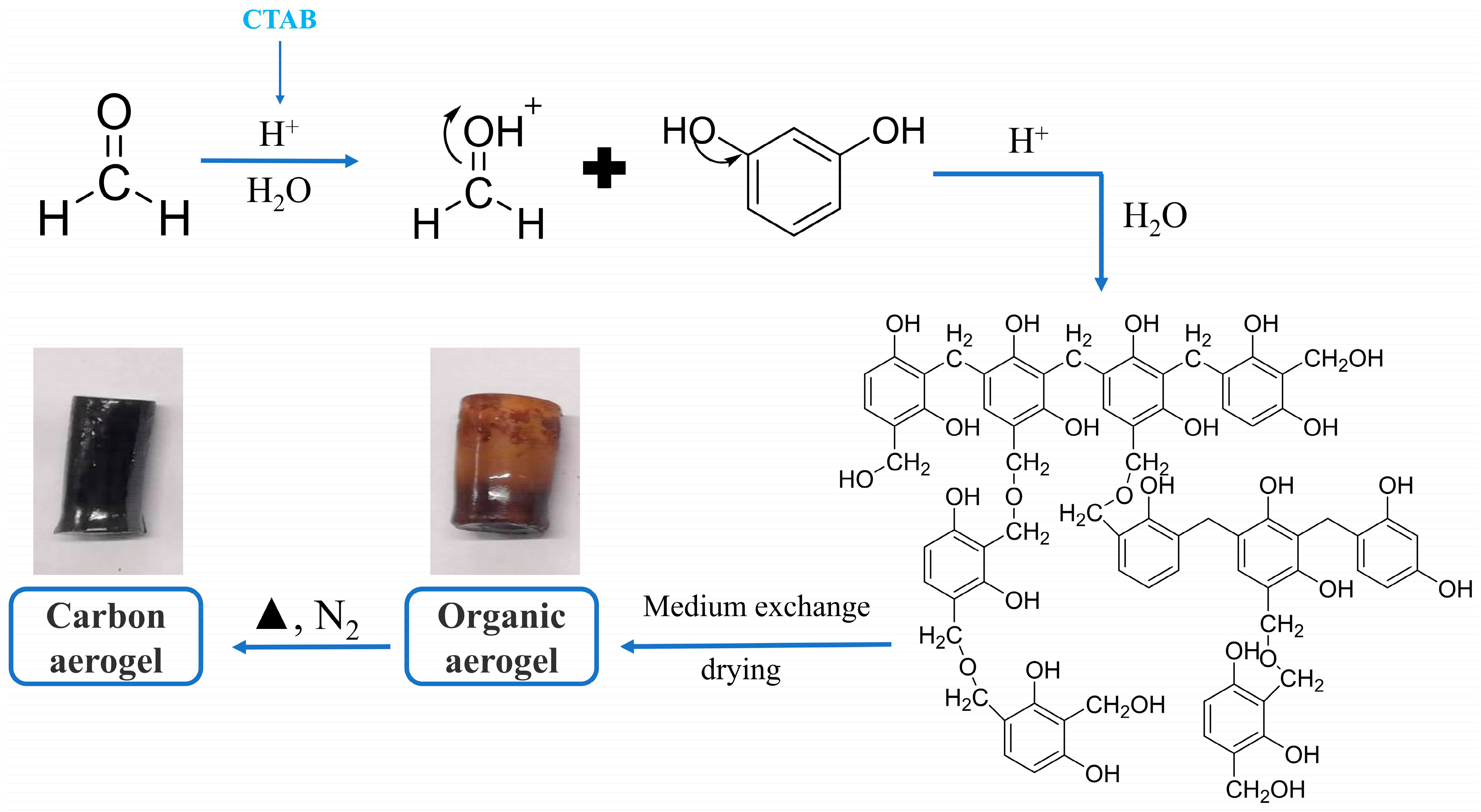
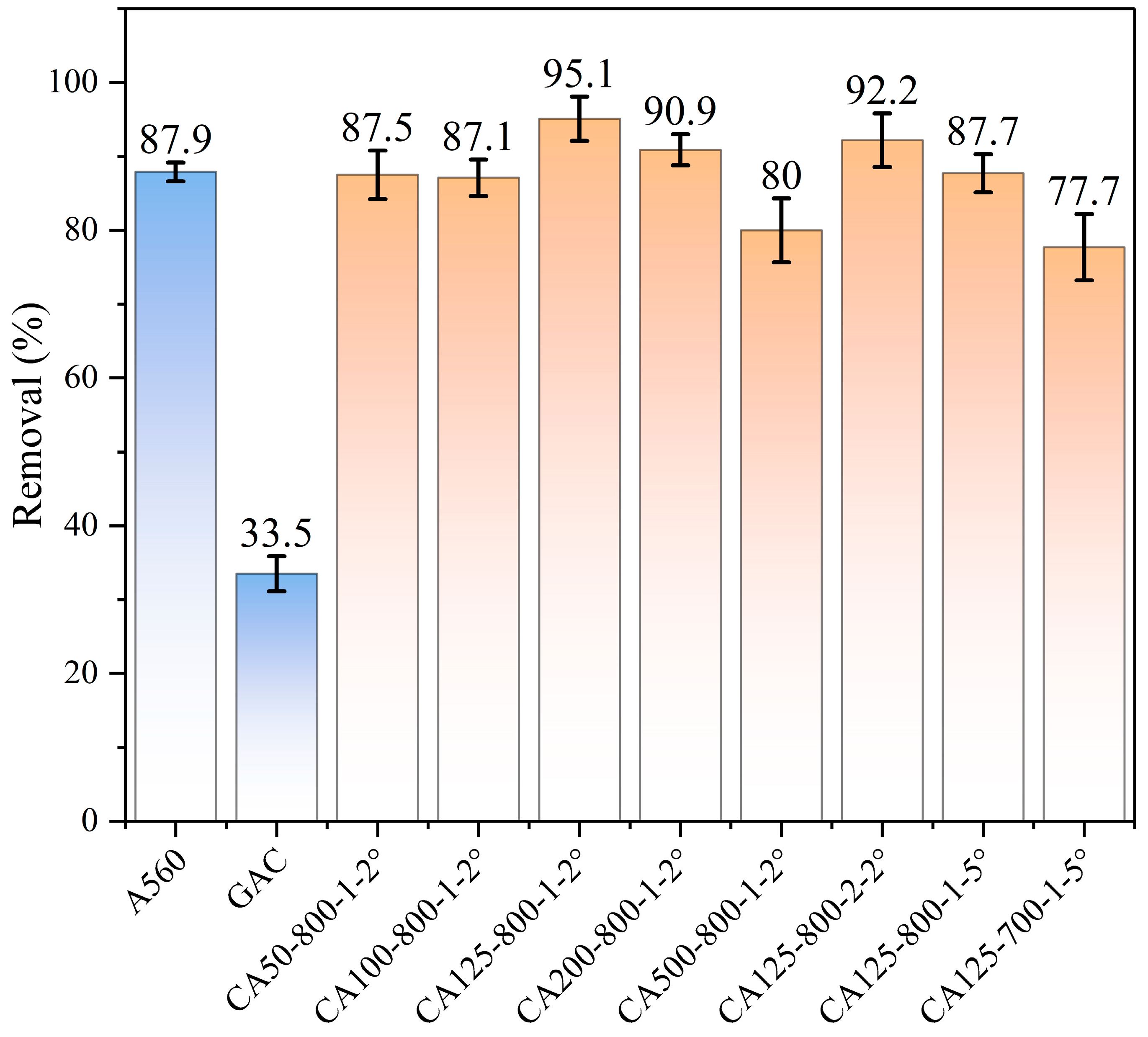
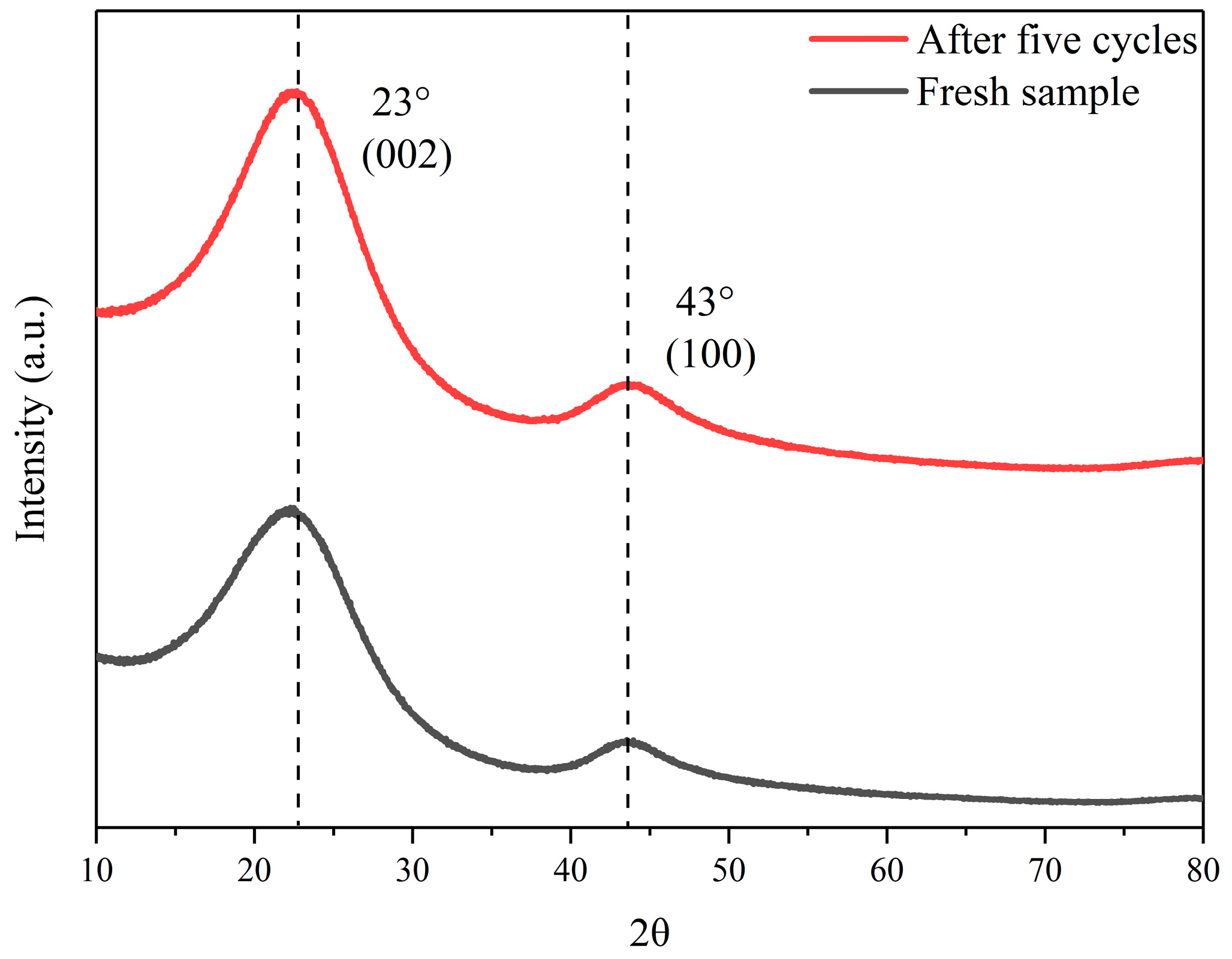

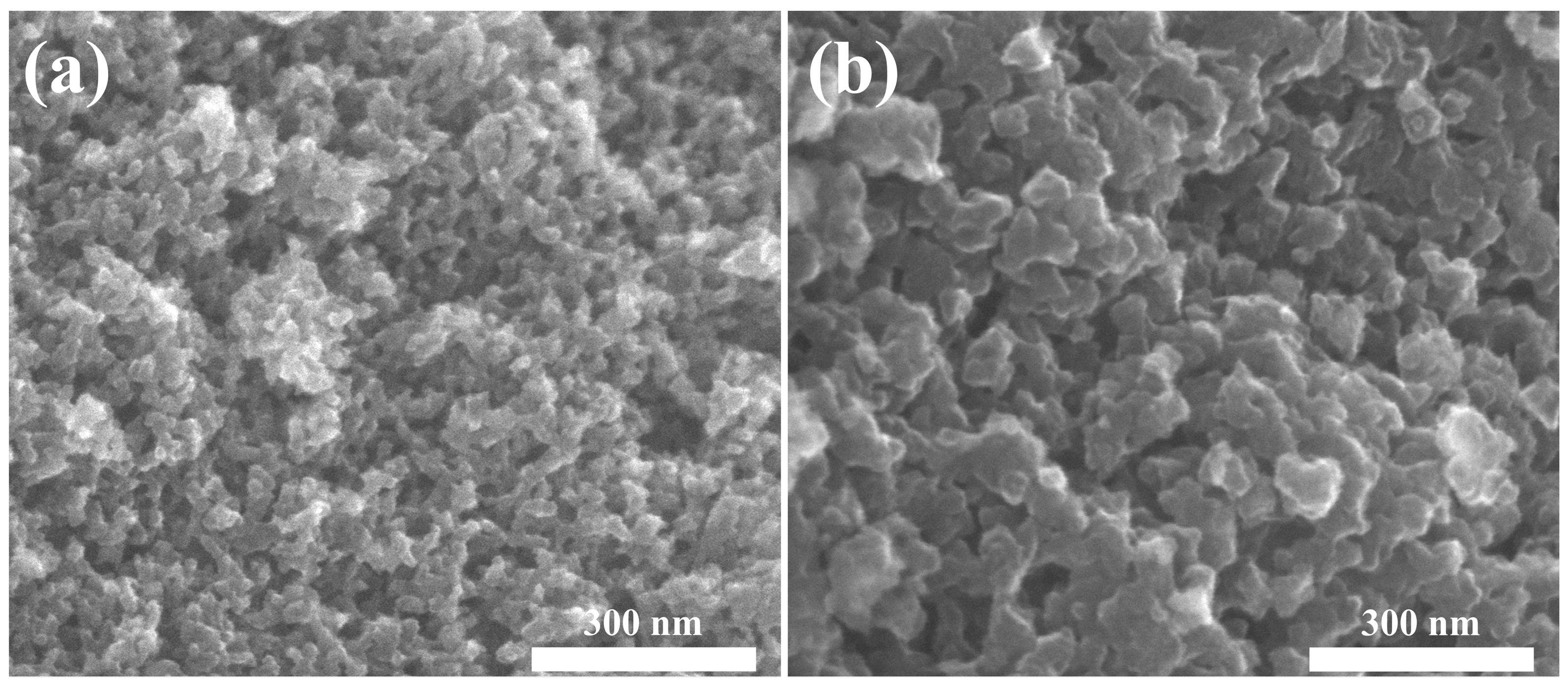
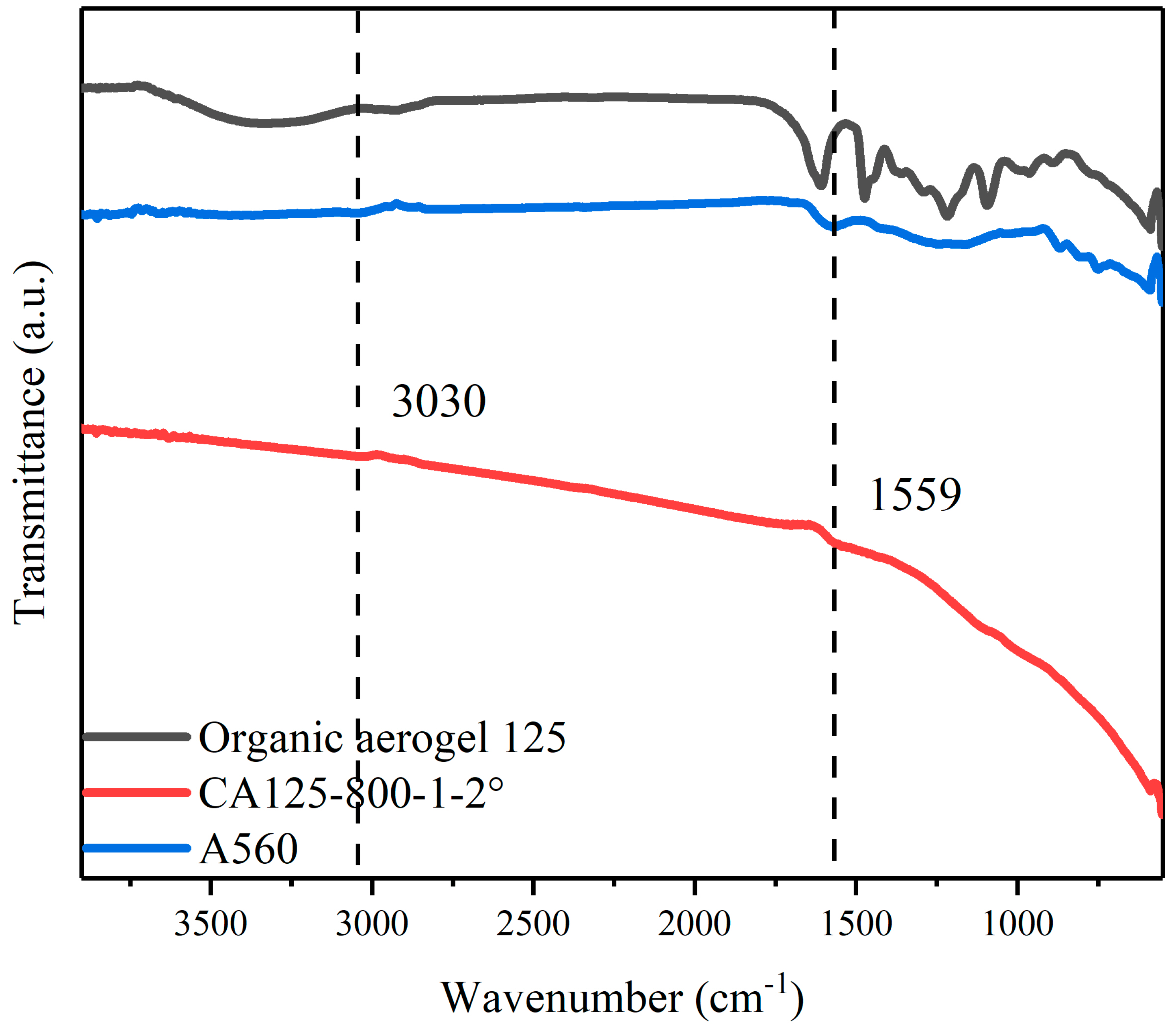
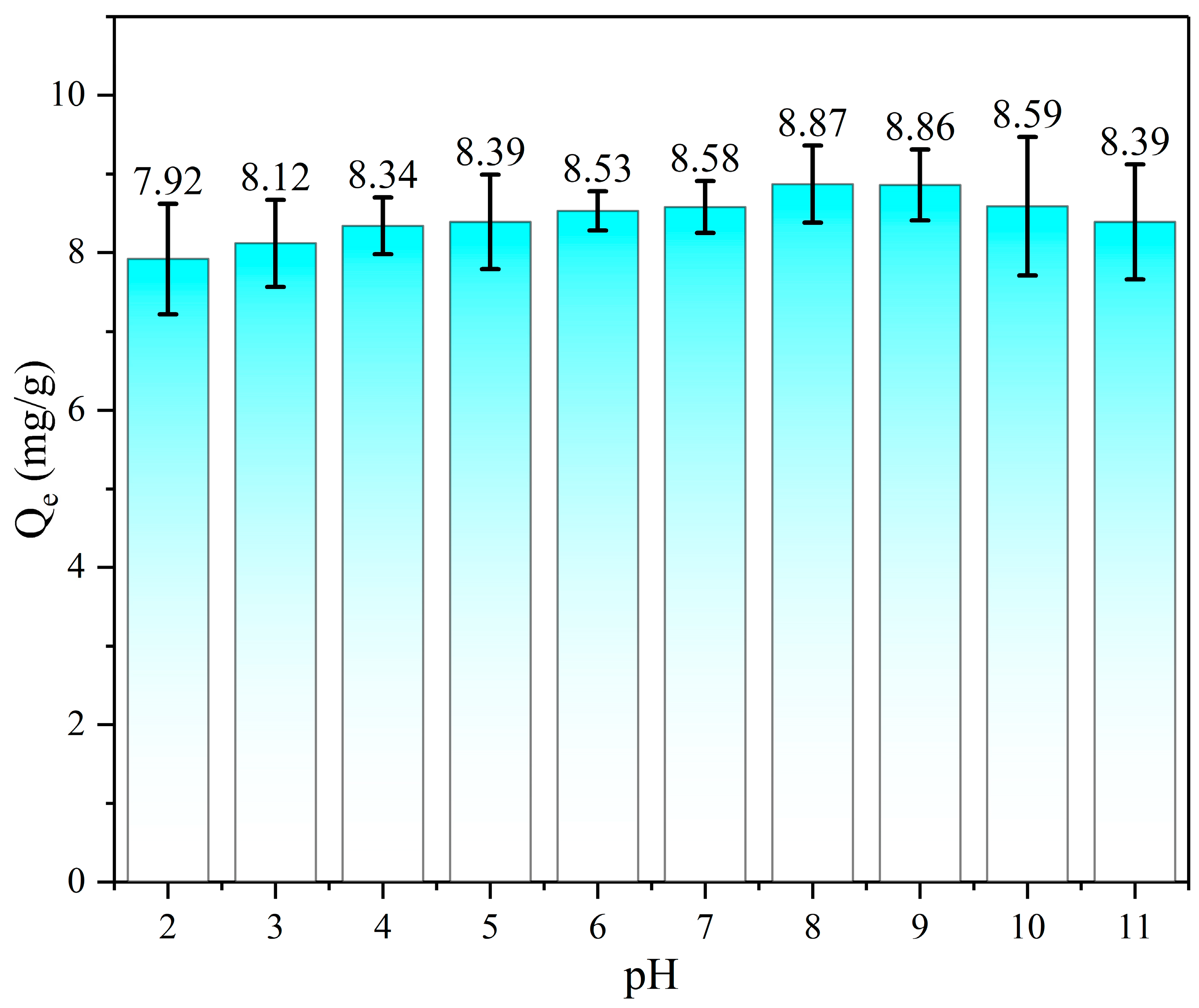
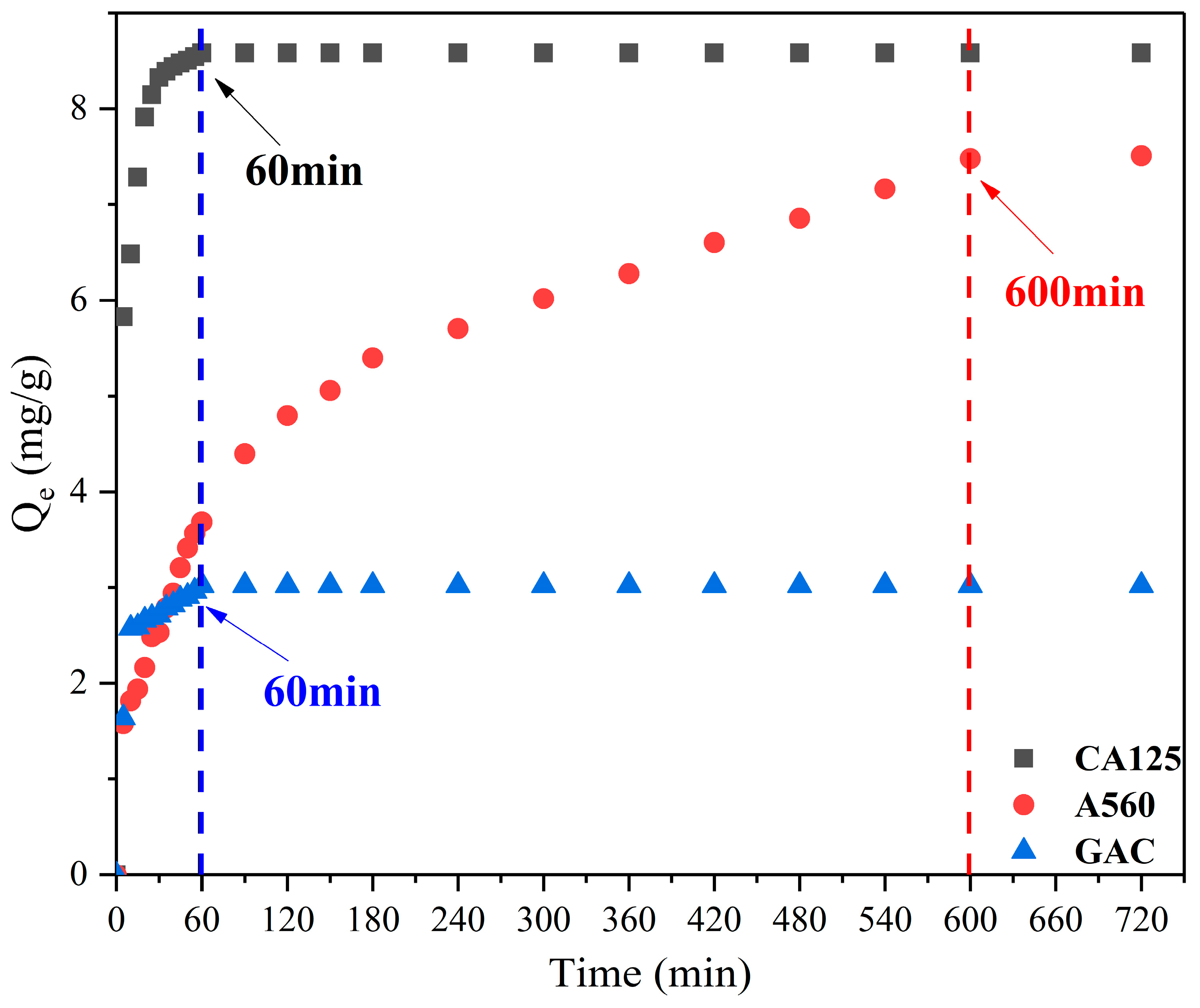
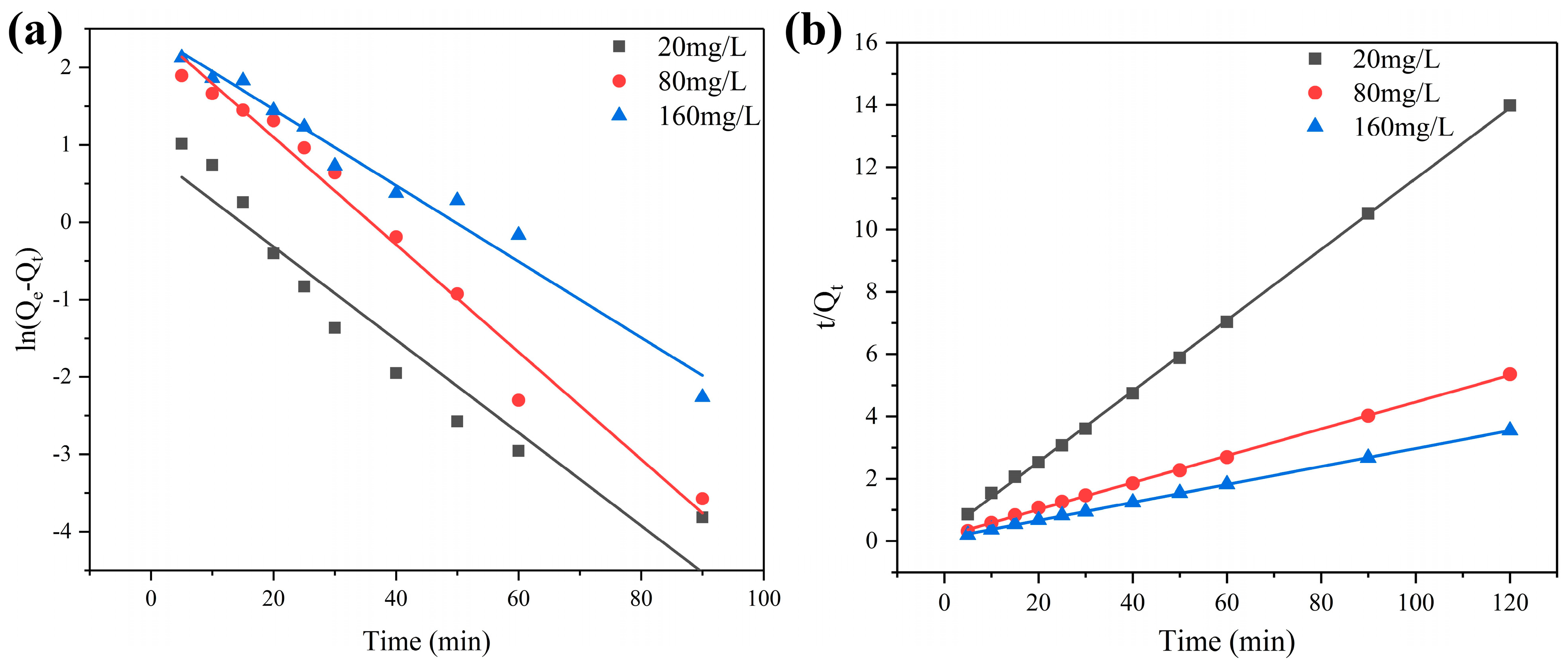

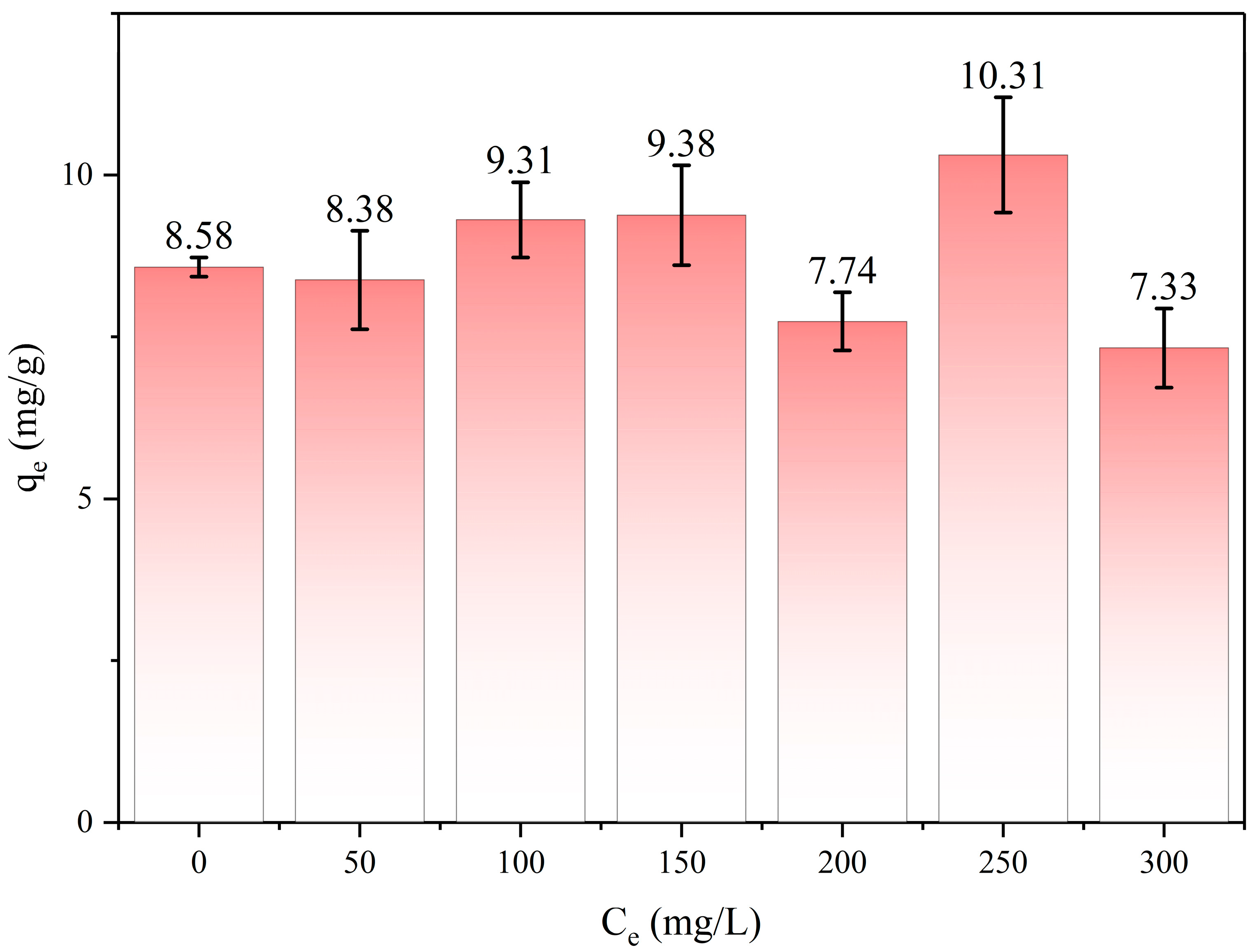
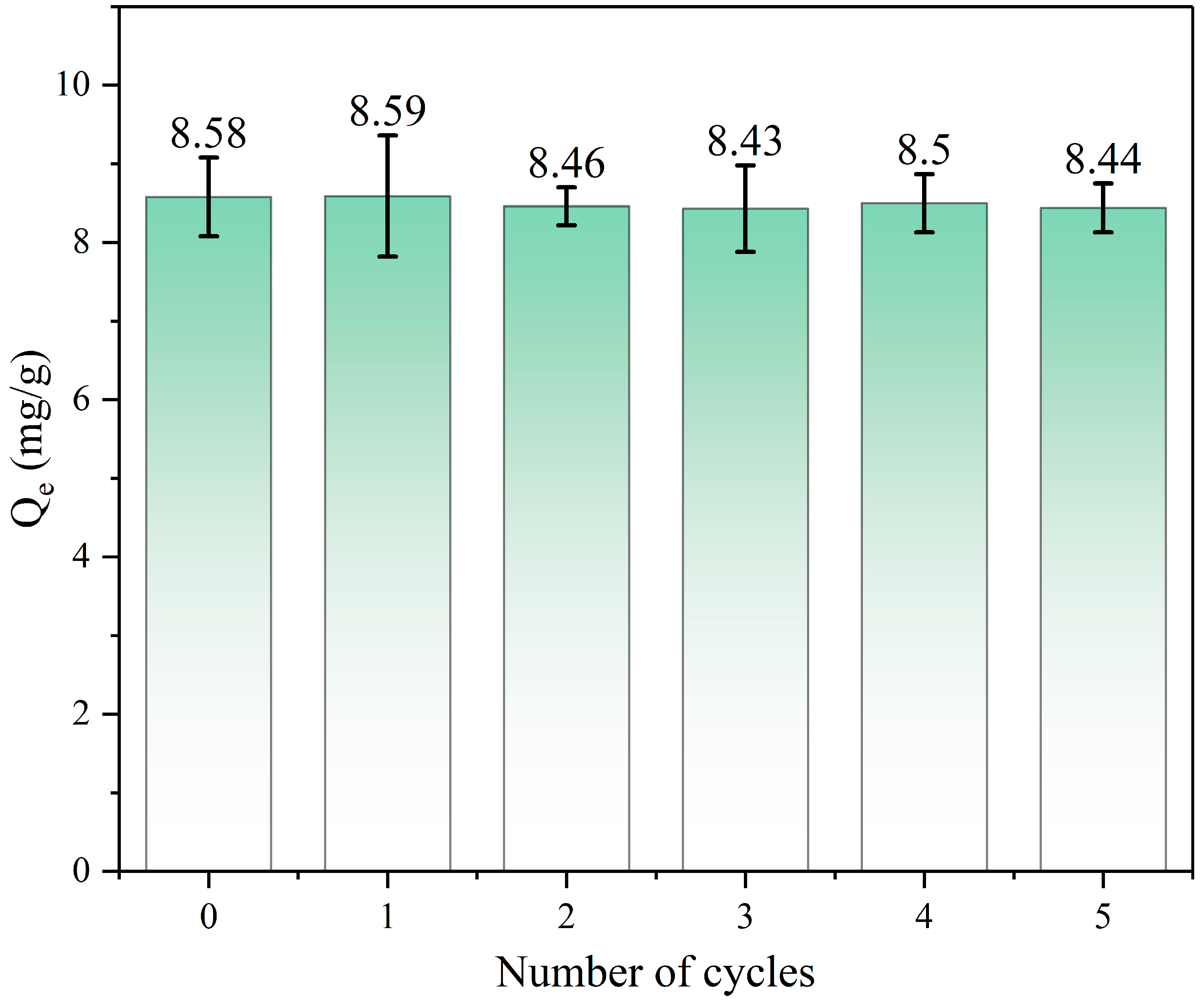

| Property | Value | Structure |
|---|---|---|
| Molecular weight | 88.11 g/mol |  |
| Water solubility | Miscible | |
| Density (25 °C) | 1.0329 g/mL | |
| Vapor pressure | 4 kPa at 20 °C | |
| Octanol–water partition coefficient (LogKow) | −0.27 | |
| Organic carbon partition coefficient (Log Koc) | 1.23 | |
| Henry’s law constant at 25 °C | 4.8 × 10−6 atm m3 mol−1 |
| Sample | SBET (m2/g) | Smicro (m2/g) | Smeso (m2/g) | Vt (cm3/g) | Vmicro (cm3/g) | Vmeso (cm3/g) | D (nm) |
|---|---|---|---|---|---|---|---|
| CA50-800-1-2° | 572 | 239 | 333 | 1.37 | 0.29 | 1.08 | 12.92 |
| CA100-800-1-2° | 638 | 287 | 351 | 1.62 | 0.29 | 1.33 | 9.47 |
| CA125-800-1-2° | 674 | 275 | 399 | 1.81 | 0.32 | 1.49 | 9.70 |
| CA200-800-1-2° | 629 | 288 | 341 | 1.63 | 0.29 | 1.34 | 9.23 |
| CA500-800-1-2° | 406 | 311 | 95 | 0.37 | 0.16 | 0.21 | 8.98 |
| CA125-800-2-2° | 605 | 258 | 347 | 1.54 | 0.29 | 1.25 | 9.11 |
| CA125-800-1-5° | 503 | 304 | 199 | 1.23 | 0.14 | 1.08 | 9.79 |
| CA125-700-1-2° | 452 | 236 | 216 | 1.54 | 0.12 | 1.42 | 13.62 |
| A560 | 480 | 251 | 229 | 0.57 | 0.14 | 0.43 | 4.51 |
| GAC | 1086 | 1069 | 17 | 0.42 | 0.39 | 0.03 | 3.83 |
| C0 (mg/L) | Qe (exp) (mg/g) | Pseudo-First-Order Models | Pseudo-Second-Order Models | ||||
|---|---|---|---|---|---|---|---|
| Qe (cal) (mg/g) | k1 (min−1) | R2 | Qe (cal) (mg/g) | k2 (mg/min) | R2 | ||
| 20 | 8.58 | 5.10 | 0.0987 | 0.9904 | 8.80 | 0.0478 | 0.9997 |
| 80 | 22.40 | 10.93 | 0.0632 | 0.9778 | 23.20 | 0.0122 | 0.9995 |
| 160 | 33.82 | 11.49 | 0.0492 | 0.975 | 34.72 | 0.0096 | 0.9998 |
| T(K) | Langmuir | Freundlich | ||||
|---|---|---|---|---|---|---|
| R2 | Qm (mg/g) | KL (L/mg) | R2 | 1/n | KF | |
| 298 | 0.97 | 37.55 | 0.0138 | 0.88 | 0.355 | 3.818 |
| 308 | 0.97 | 38.69 | 0.0113 | 0.86 | 0.410 | 2.360 |
| 318 | 0.99 | 67.28 | 0.0045 | 0.97 | 0.546 | 1.748 |
| T (K) | ΔG (kJ/mol) | ΔH (kJ/mol) | ΔS (J/mol/K) |
|---|---|---|---|
| 298 | −26.83 | −52.71 | −85.99 |
| 308 | −26.75 | ||
| 318 | −25.08 |
| Mass (mg) | CA125-800-1-2° | A560 | GAC |
|---|---|---|---|
| 20 | 85.81% | 75.71% | 21.54% |
| 40 | 91.13% | 85.99% | 27.45% |
| 60 | 95.08% | 87.89% | 33.47% |
Disclaimer/Publisher’s Note: The statements, opinions and data contained in all publications are solely those of the individual author(s) and contributor(s) and not of MDPI and/or the editor(s). MDPI and/or the editor(s) disclaim responsibility for any injury to people or property resulting from any ideas, methods, instructions or products referred to in the content. |
© 2024 by the authors. Licensee MDPI, Basel, Switzerland. This article is an open access article distributed under the terms and conditions of the Creative Commons Attribution (CC BY) license (https://creativecommons.org/licenses/by/4.0/).
Share and Cite
Lu, T.; Huang, H.; Lv, G.; Li, F.; Song, R.-j.; Cai, Y. Adsorption Behavior and Kinetics of 1,4-Dioxane by Carbon Aerogel. Toxics 2024, 12, 145. https://doi.org/10.3390/toxics12020145
Lu T, Huang H, Lv G, Li F, Song R-j, Cai Y. Adsorption Behavior and Kinetics of 1,4-Dioxane by Carbon Aerogel. Toxics. 2024; 12(2):145. https://doi.org/10.3390/toxics12020145
Chicago/Turabian StyleLu, Tianyu, Huihui Huang, Guifen Lv, Fei Li, Ren-jie Song, and Yuting Cai. 2024. "Adsorption Behavior and Kinetics of 1,4-Dioxane by Carbon Aerogel" Toxics 12, no. 2: 145. https://doi.org/10.3390/toxics12020145





